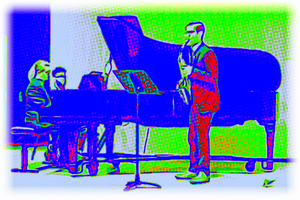Ben Tibbetts Studio Home Services Archive Students About Contact Now Store Subscribe
Four Seasons

Four Seasons is a collection of short saxophone sonatas. They depict summer, autumn, winter, and spring on baritone, tenor, soprano, and alto saxophones respectively.
The baritone and tenor saxophone pieces were recorded by Peter da Silva. The soprano and alto saxophone pieces were recorded by Nick Suosso. I'm very grateful to Peter and Nick for their work on this project.
Summer Sonatine for baritone saxophone
1. Final Exams
2. Pastorale
3. Holiday
Autumn Sonatine for tenor saxophone
1. All Hallows' Eve
2. Leafer Madness
3. Fall
Winter Sonatine for soprano saxophone
1. Snow Dance
2. Cold and Still
3. Storm and Sanctuary
Spring Sonatine for tenor saxophone
1. Blossom
2. Child's Play
3. Skinned Knee
4. Bicycle Race
The first piece is in three movements: "Final Exams", "Pastorale", and "Holiday". "Final Exams" portrays the end of a semester. There's a specific feeling I thought about when I wrote it. As a semester concludes, it feels for a while like things are accelerating and becoming more stressful. Everybody's preparing for the final exams. There's homework and grading to do. At the same time, you're anticipating the break. It's a transitional period.
Then there comes a moment when there's nothing you have left to do, because school is out and the semester has truly ended. I associate that moment with relief and exhaustion. In movement two, "Pastorale", I tried to capture those emotions. That music moves smoothly into movement three, "Holiday", which is inspired by the pleasures and freedom of summer vacation.
The second piece depicts autumn in three movements: "All Hallow's Eve", "Leafer Madness", and "Fall". "All Hallow's Eve" is creepy and unsettling. It's inspired by the strange holiday of Halloween. The title of the second movement, "Leafer Madness", is a play on words. In the U.S., "leafer" is slang for someone who visits heavily wooded areas in the autumn to enjoy the changing foliage; and "Reefer Madness" was a 1936 propaganda movie in which kids became addicted to marijuana. This pun captures the mood of this movement for me: it's manic and euphoric, like a stoner surrounded by colorful leaves.
The third movement, "Fall", is more plaintive. I try to capture the more poignant, tragic elements of autumn. The last leaves fall and the trees become barren. The birds leave for warmer places. Although we generally do our best not to think about it, autumn reminds us that everything changes and one day we will die.
The third piece depicts a snowy winter. "Snow Dance", the first movement, portrays wintery activities that I associate with fun and leisure, like ice skating and sledding. The second movement, "Cold and Still", evokes the heavy malaise that many people struggle with in the dark months (sometimes called "seasonal affective disorder"). And the final movement, "Storm and Sanctuary", is inspired by watching a snowstorm unfold from inside a cozy home. You look out the window and see mayhem—you can hear the wind, snow, and sleet—but inside, all is well. You are warm and healthy. You have wood for the fire and food in the pantry.
The final piece is inspired by spring. The first movement, "Blossom", represents a flower blooming as the weather gets warmer and the snow gradually melts. The second movement is called "Child's Play", and when I wrote it I was thinking about a child playing outside. Then the third movement, "Skinned Knee", made me think of the same child experiencing some small physical injury.
It's interesting to contrast this third movement with the third movement of the autumn sonata. In "Fall", I think of the character as experiencing the emotions of real, serious tragedy; but this movement feels more like melodrama than drama. The pain is genuine but the injury itself isn't a big deal. The kid's going to be fine.
In movement four, "Bicycle Race", I imagine the kid a little older and playing on a bicycle with other children. Here the energy feels bubbly and rambunctious. The movement is generally playful, although it slows down at one point to recall material from movement one, "Blossom". I did this because I wanted to make an analogy between the blossoming of a flower and the process of growing up. Spring is a season that makes me feel optimistic and contemplate new beginnings, so this imagery felt appropriate.

Ben Tibbetts Studio Home Services Archive Students About Contact Now Store Subscribe


Copyright © 2006-2023 Ben Tibbetts
change log